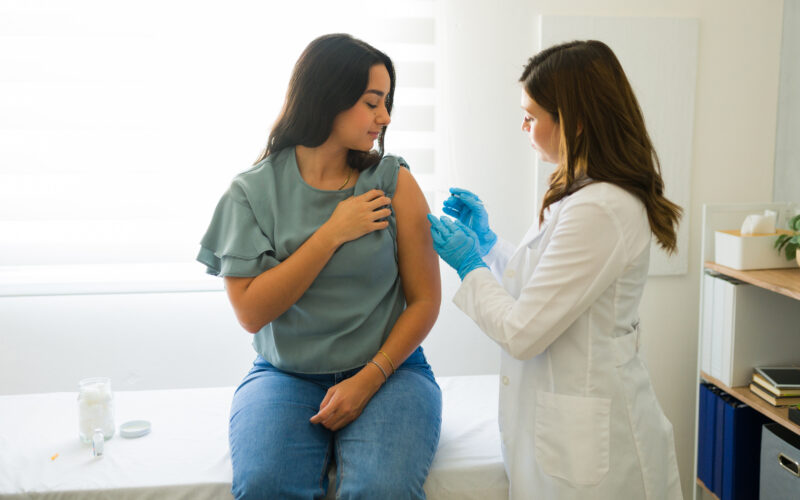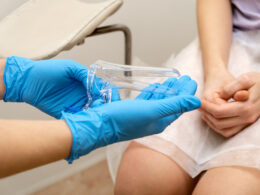So you’ve got a routine pap smear appointment coming up. Or maybe your 11-year-old child is getting ready for their physical and you noticed they’ve got a recommended vaccine at this visit (Gardasil). In either case, you might be asking yourself, what is HPV, exactly? And how much should I be worried about it?
What is HPV?
Human papillomavirus (HPV) is a family of viruses that causes warts on different parts of the body. Depending on your source, there are 150+ or 200+ different strains of HPV, and different strains affect different body parts. Some cause warts on hands, or feet, or the face. Others can cause genital warts. A small percentage of HPV strains can cause cancer.
HPV spreads by skin-to-skin contact, which will vary depending on the strain in question. You can catch a strain of HPV that causes plantar warts by not wearing sandals in a public locker room, for example. The strains of HPV that cause genital warts are sexually transmitted.
Most HPV infections are annoying at most. They’re benign, and 90% resolve on their own within 2 years. However, algunos kinds of HPV can cause cancers. The 12 high-risk strains that can cause cancer are all sexually transmitted infections (through oral, vaginal, or anal sex) and can cause cervical, throat, anal, vaginal, vulvar, and penile cancers.
Detecting HPV is important to prevent cervical cancer
This is why it’s so important to get your regularly scheduled frotis de Papanicolaou. Doctors now recomiende a papanicolaou (“pap”) smear every 3 years for women aged 21-29, then every 5 years for women aged 30-65, together with an HPV DNA test (more on this below). Researchers have discovered that it can take 10-15 years for cervical cancer to develop from an HPV infection, so testing is no longer recommended every single year.
Importantly, the strains of HPV most likely to cause cancer do no cause genital warts, so getting your regular pap smear may be the only way to know that you’re at risk for cervical cancer.
What will happen if your pap smear comes back abnormal?
Pap smears are a simple procedure that looks for precancerous cell changes in the cuello uterino, called cervical dysplasia. If you have an abnormal result, your doctor may order a colposcopy, which is similar to, but more uncomfortable than, a pap smear. The doctor will examine the cervix with a speculum, a magnifier, and some acid which will help them identify any concerning cells in order to take a biopsy.
Most low-level cell changes are unlikely to develop into cancer, so your doctor may simply keep an eye on future pap smear results, which you’ll have more frequently than a woman with normal results. If you have moderate- to high-grade changes, your doctor will discuss your options.
What is an HPV DNA test?
While pap smears look for damaged cervical cells, there is also a HPV test that looks directly for the DNA of HPV viral cells in your system. This HPV DNA test is done the same way, and possibly at the same time, as a standard pap smear, and is recomendado for women ages 30-65 every 5 years
When can you stop getting HPV screenings?
If you’ve had no abnormal results by the time you turn 65, you no longer require routine HPV screening.
HPV treatment
Benign warts, including sexually transmitted genital warts, can be frozen off. Consult a doctor if your warts are causing discomfort. Otherwise, a healthy body should clear the virus on its own, though it may take up to 2 years.
Can you avoid HPV?
Yes and no.
For non-genital HPV, common sense rules can help avoid spreading the virus. Don’t pick at warts or bite your nails. Wear sandals in public locker rooms and showers.
When it comes to genital HPV strains, know that HPV is the más comunes STI in the United States. Approximately 80% of American women will get at least one strain in their lifetime, and most won’t ever know they had it. That said, the risk is not the same as for non-genital strains of HPV, as you have to get an STI de someone.
Who is at risk for sexually transmitted HPV?
Those who become sexually active antes de the age of 18 are more likely to contract HPV. Having multiple sexual partners, or a partner who’s had multiple partners, will increase your odds as well. The more partners you have, the higher the chance one of them will give you HPV.
Anything that damages your immune system, such as HIV, anti-rejection drugs for those who’ve received an organ donation, will put you at greater risk of HPV and other STIs.
Women who smoke are twice as likely to develop cervical cancer as non-smokers.
The bacteria that cause chlamydia can help the HPV virus grow, so a history of chlamydia—even after it’s cleared—can increase your risk of cervical cancer as well.
Hormonal birth control and HPV risk
Long-term oral contraceptive use has been linked with an mayor riesgo of HPV infection [1]. This risk goes up the longer you’ve been on contraceptives, but then slowly decreases again once you discontinue use. (Yet another reason to ditch your hormonal birth control and learn a fertility awareness method!)
The debate about IUDs and cervical cancer risk
While intrauterine devices (IUDs) are known to cause genital tract inflammation (which could theoretically make a person more susceptible to genital HPV infection), evidence is mixed on whether IUDs decrease cervical cancer risk or not. In one Metaanálisis de 2018, having ever used an IUD was linked with an approximately 30% disminución risk of cervical cancer compared to having never used an IUD [2].
Sin embargo, un Estudio de 2018 of women who had recently used either a copper IUD or the hormonal Levonorgestrel (LNG) IUD found that compared to women who did not use contraception, women who used a LNG IUD were more likely to develop precancerous CIN2 lesions (cervical intraepithelial lesions or CIN lesions). CIN2 lesions are less severe than CIN3, and women who recently used LNG IUDs were at higher risk of CIN2 but no CIN3 lesions. Cervical cancer risk in the LNG IUD users was similar to risk in users of other forms of hormonal contraception. Women who used the copper IUD were no found to be at increased risk for cervical cancer.
How to eliminate your risk of sexually transmitted HPV
Condoms are often suggested to help avoid spreading HPV, but no condom will cover every affected area of the body.
As with any STI, abstinence and monogamy can effectively eliminate your risk. The virus is transmitted via skin-to-skin contact, not just of the genitals, but also the skin on your hands or mouth. This means that someone who has not engaged in sexual intercourse could still catch HPV from other types of sexual activity/foreplay.
HPV and pregnancy
In rare cases, HPV can be transmitted vertically via vaginal birth. A Estudio 2023 in Montreal found that most of the few babies who caught HPV from their mothers cleared the infection on their own within 6 months [4].
In very rare cases, infants with HPV have developed recurrent respiratory papillomatosis (RRP) which causes recurrent, non-cancerous tumors in the throat or lungs.
The potential complications to a baby born to an HPV-positive mother are so rare that there is no routine HPV testing recommended for a typical pregnancy workup. If you’re due for a pap smear, though, you can get it during one of your prenatal appointments.
The HPV vaccine
The HPV vaccine, Gardasil, has been on the market since 2006. The original version protected against four HPV strains that could cause cervical cancer. In 2014, it was updated to include the nine strains of HPV most likely to cause cervical, penile, vulvar, vaginal, oral, head, and neck cancer and/or genital warts. Because of this, it’s often marketed as a “cancer vaccine”—the only one of its kind. Keep in mind that Gardasil remains fundamentally an HPV-related cáncer de cuello uterino vaccine since, according to the Organización Mundial de la Salud (WHO), an estimated “91% of HPV-related cancers in women in 2018 were cervical cancers.”
Doctors recommend that both boys and girls should receive the Gardasil vaccine at the age of 11 or 12, as the vaccine works best if it’s administered antes de the patient becomes sexually active. However, although the Gardasil HPV vaccine has been around for almost 20 years now, it’s still controversial among some parents.
Those opposed say…
Gardasil vaccine skeptics question the necessity of a vaccine targeting a sexually transmitted infection that can be avoided by lifestyle choices (recall that all of the high-risk HPV strains capable of causing cancer, nine of which are covered by Gardasil, are sexually transmitted). Why, they ask, would you need a vaccine if you’re practicing abstinence?
Additionally, the WHO notas that “The large majority of cervical cancer cases in 2020 (88%) occurred in (low or middle income countries), where they account for 17% of all cancers in women, compared with only 2% in high-income countries.” Women from sub-Saharan Africa were the most likely to experience HPV-related cervical cancer, and these same women experienced high rates of highest human immunodeficiency virus (HIV). The WHO spelled out, “HPV infection is more likely to persist and progress to cancer in women living with HIV.” As a consequence, “Mortality rates vary 50-fold between countries, ranging from <2 per 100,000 women in some (high income countries) to >40 per 100,000 in some countries of sub-Saharan Africa.” All of this makes some American parents question whether the vaccine is necessary for their preteens.
Finally, as with any medical intervention, there are potential side effects to the vaccine, some of which may still be unknown or unexplored. Current demandas against Merck, the manufacturer of Gardasil, allege that the vaccine has caused auto-immune disorders, fertility problems, and cancers in the plaintiffs.
Those in favor say…
Proponents of the Gardasil vaccine stress that the 9 strains included in the vaccine are the most common high-risk HPV strains, and estimación that the vaccine will prevent about 90% of cervical cancer cases.
A Estudio de 2012 looked into the question of whether receiving the HPV vaccine would encourage promiscuity in young girls (a concern expressed by some opponents of the vaccine). Researchers found no difference in pregnancy or STI rates, concluding that the HPV vaccine “was not associated with increased sexual activity-related outcomes” [5]. Proponents likewise point out that it’s important to vaccinate antes de children become sexually active (either as teens or adults), and that even if one expects their own child to remain abstinent, they cannot guarantee that their child’s future partner(s) will have done the same.
Being vaccinated doesn’t change how often you should get a pap smear
Importantly, girls and women who’ve received Gardasil still have to follow the same recommended pap smear schedule as women who haven’t received the shot. This is in part because cervical cancer, like all the other cancers HPV can lead to, can still be caused by other factors. Gardasil may prevent HPV-related cervical cancer, but, as the Gardasil website notes, a girl or woman who received it may still develop cervical cancer for other reasons.
The bottom line on HPV
Since HPV is so common, you might not be able to completely eliminate your risk, depending on your circumstances. Still, you can decrease your chances of contracting HPV by lifestyle choices like abstinence, monogamy, and/or discontinuing hormonal birth control. Following your doctor’s recommended pap smear schedule will ensure you catch any concerning cervical changes early.
Related reading:
Vaginal cancer: What causes it and could you be at risk?












This is an excellent article but I would encourage the writer to include a paragraph with citations about the outsized severe adverse reactions women and girls have had to the Gardasil vaccine. The mention of lawsuits is insuffcient. The lawsuits are so many that they’ve been consolidated, which says a lot about the vaccines’ toxicity. Women and girls have died or been permanently disabled.
I did not allow my daughters to have the vaccine, but they did get all the others.
The military, by the way, is still pushing the vaccine to even men in their 20s.